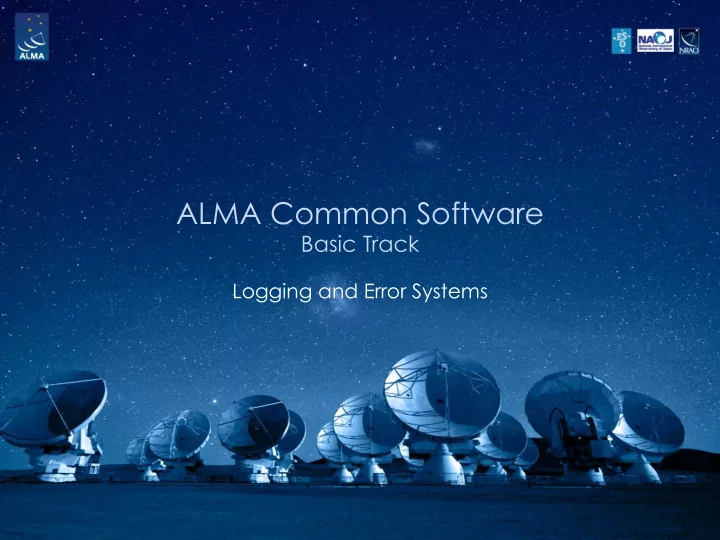

ALMA Common Software Basic Track Logging and Error Systems
Logging system conceptual overview
Logging system ² The logging system provide ² status and diagnostic information ² historical archive ² filtering capabilities by level/audience ² Several logging levels: ² Trace (1), Delouse (2), Debug (3), Info (4), Notice (5), Warning (6) , Error (8), Critical (9), Alert (10), Emergency (11), Off (99) ² Three logging audiences (orthogonal to log levels): ² ENGINEER, OPERATOR, SCILOG ² They are essential for post-mortem analysis ² They are normally intended for developers and operators
Logging system ² Logging service: ² Transport through a notification channel ² Graphical user interface to visualize them in runtime or offline (jlog) ² For later processing can be: ² written to file ² stored in DB ² For high performance / robustness: ² Transparent caching ² Transfer asynchronously in batches ² Transparent insertion of additional data: ² host / container names ² thread name Warning: Every logging client considerably slows down the logging system! Congestions can lead to a logging service crash
Repeat guards: preventing log flooding ² Conveniently reduce number of executions of identical activity ² e.g. Logging of same log message, e.g. “incident detected”, N times/s ² Can be used for other activities, is wrapped around activity ² Configurable based on: ² Number of executions ² Time interval ² Combinations of both
Log entry example <Debug � � TimeStamp="2002-10-7T13:44:16.530" � Host=“te1.hq.eso.org“ � � Process="baciTestServer“ � � Thread="main" � � Context="“ � � File="baciTestClassImpl.cpp“ � � Line="205" � Routine="BaciTestClass::~BaciTestClass � > �
Logging system configuration ² Default configuration ² log TRACE and above levels ² Optional environment variables can set per-process log levels ² CDB can set per-process log levels / per-logger level ² Tools to dynamically change log levels in running system ² Environment variables: ² Log level for console: $ACS_LOG_STDOUT � ² Central logging level: $ACS_LOG_CENTRAL � ² Log file name: $ACS_LOG_FILE �
Error system ² ACS: faults or errors are a situation that requires handling ² Handled by developer ² Helpers (acserr.idl): ² Completion ² Not critically failed execution / execution OK ² Errors ² Critically failed execution ² ACS (CORBA) exceptions predefined in XML (ACSErrTypeCommon.xml, ACSErrTypeCommon.idl) ² Error propagation → Error trace ² Chaining of Completions ² Chaining of errors / ACS exceptions ² Possible across process boundaries
Error system conceptual overview
Resources ² Logging and Archiving: ² http://www.eso.org/projects/alma/develop/acs/ OnlineDocs/Logging_and_Archiving.pdf � ² Definitive guide to logs and errors ² http://almasw.hq.eso.org/almasw/bin/view/HLA/ LoggingErrorAlarmsGuidelines � ² And of course, the source code
Questions? Acknowledgements ACS presentations were originally developed by the ALMA Common Software development team and has been used in many instances of training courses since 2004. Main contributors are (listed in alphabetical order): Jorge Avarias, Alessandro Caproni, Gianluca Chiozzi, Jorge Ibsen, Thomas Jürgens, Matias Mora, Joseph Schwarz, Heiko Sommer. The Atacama Large Millimeter/submillimeter Array (ALMA), an international astronomy facility, is a partnership of Europe, North America and East Asia in cooperation with the Republic of Chile. ALMA is funded in Europe by the European Organization for Astronomical Research in the Southern Hemisphere (ESO), in North America by the U.S. National Science Foundation (NSF) in cooperation with the National Research Council of Canada (NRC) and the National Science Council of Taiwan (NSC) and in East Asia by the National Institutes of Natural Sciences (NINS) of Japan in cooperation with the Academia Sinica (AS) in Taiwan. ALMA construction and operations are led on behalf of Europe by ESO, on behalf of North America by the National Radio Astronomy Observatory (NRAO), which is managed by Associated Universities, Inc. (AUI) and on behalf of East Asia by the National Astronomical Observatory of Japan (NAOJ). The Joint ALMA Observatory (JAO) provides the unified leadership and management of the construction, commissioning and operation of ALMA.
Recommend
More recommend